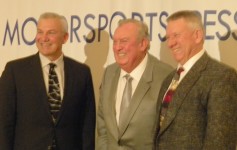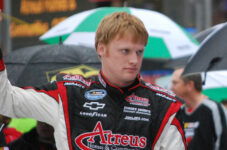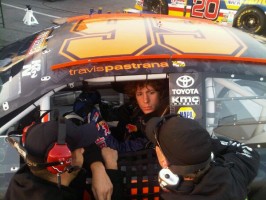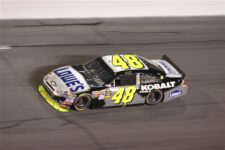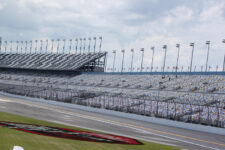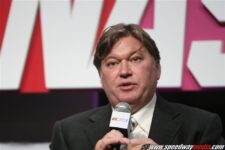One of them is his son. The other drives his car.
The 53rd running of the Daytona 500 will see both men attempting to win the Great American Race for the second time. And now more so than ever they’ll be the sentimental favorites.
Not as if they normally aren’t with the fan base each possess, but this year with the 10th anniversary of Dale Earnhardt’s death those fans are looking for an emotional victory.
[media-credit name=”Brad Keppel” align=”alignright” width=”240″]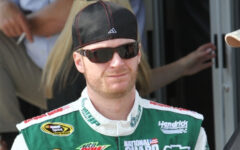 [/media-credit]When Earnhardt died on the last lap of the 2001 Daytona 500 it forever linked Dale Earnhardt Jr. and Kevin Harvick. It forever made them two drivers fans would always cling to when thinking about Earnhardt Sr.
[/media-credit]When Earnhardt died on the last lap of the 2001 Daytona 500 it forever linked Dale Earnhardt Jr. and Kevin Harvick. It forever made them two drivers fans would always cling to when thinking about Earnhardt Sr.
As the son, Earnhardt Jr. has been cursed with unnecessary expectations. As the man picked to drive his car, Harvick was given big shoes to fill. They both have honored the Intimidator in their own ways while creating a legacy of their own.
The passing of his father brought Earnhardt Jr. more fans and attention than he already had. Greatness once expected with time became greatness expected now, become his father.
Success he enjoyed in his rookie year, winning his first race at Texas and becoming the first rookie to win the All-Star race, was shared with dad in victory lane. A family sport had one its greatest families stealing the headlines.
Then, dad was gone and ‘Little E’ was on his own and forced to become the man of the household.
As a new season begins and another Daytona 500 approaches, along with another anniversary, Earnhardt Jr. will be bombarded with questions about his father. It may even be blessing in disguise from talking about another disappointing year, 2010, and the changes at Hendrick Motorsports over the offseason.
“You know, you think about your parents all the time,” Earnhardt Jr. said last week during preseason testing. “I think about him and my mother all the time, especially getting back to racing.”
Getting back to racing seems quite different when having to start the season off at the same track that took his fathers life. Except, Earnhardt Jr. not only enjoys racing at Daytona but enjoys being able to carry on the success of the Earnhardt name at the track.
In 2004 when he won his first Daytona 500 it came five years to the day that his father has won his first. Last July Earnhardt Jr. drove a blue and yellow No. 3 to victory lane at Daytona in a Nationwide Series race and the sport went into a frenzy.
Big headlines accompanied a big celebration. There were beer baths in the grandstands. Three fingers were raised high above their heads. It was a great night to honor a man that will always be a champion of the people and great night for Earnhardt Jr. to make dad proud.
“He was intimidating like they say,” said Earnhardt Jr.
“He was like that as a father when he was at home. You wanted to please him all the time, make him happy and you wanted to – whatever you did – you wanted it to somehow get a response from him,” he continued.
“My dad was there to guide me in a lot of good directions that helped me out a lot. I tried to have some of the same good qualities that he had. The qualities that I enjoyed about him, I tried to emulate those as best I could and keep those qualities as well because I felt like it made him a good person.”
Earnhardt Jr. hasn’t seen victory lane at Daytona in the Cup Series since 2004. While he’s picked up where dad left off in plate dominance, the last few years have been tough to swallow. Hope is not lost, however, Earnhardt Jr. has been magic in emotional races in the past.
Long live the 2001 Pepsi 400.
Just like long live the 2007 Daytona 500. Richard Childress had not been to victory lane at Daytona since 1998 and after the last lap of the Daytona 500 in 2001 he thought about giving it all up.
Six years to the day and on the last lap again, Harvick reminded Childress why he had made the right decision. A pass on Mark Martin put RCR back on top and put Harvick in the history books.
It was a long journey not just for Childress but for NASCAR, the fans and for Harvick himself.
“I was very uncomfortable with it in the beginning, didn’t like it, didn’t want to be a part of it,” Harvick said of the emotions of being the successor to Earnhardt.
“You know as the last three or four years have come, I’ve learned to become more comfortable. And I think the biggest reason is we’ve been able to accomplish a lot of things on our own. So that for me is something that makes me a little bit more comfortable with it. And the hardest part for me to learn was just the fact that a lot of times it wasn’t somebody trying to make you do something like he did, it was just somebody complimenting on things that he did and things that we’ve been able to do.”
His feelings are understandable. Harvick was still trying to make a name for himself in 2000 in the Nationwide Series before being handpicked by Childress to replace Earnhardt. In the wake of losing a hero, friend and boss and having never made a start in the Cup Series, it was a tall order for Harvick.
Every eye was on him. An emotional win in Atlanta three weeks after the ill-fated Daytona 500 helped relive the pain. Then there were times when it felt like Earnhardt wasn’t gone because of the actions Harvick found himself in.
A Truck Series altercation at Martinsville led NASCAR to benching him for the Cup race a day later. After being wrecked at Bristol by Greg Biffle he ran down pit road, jumped over the car and grabbed the driver, exchanging heated words.
Harvick has never been one to shy away from speaking what at times has been the truth or what he’s feeling. Losing Earnhardt made it become a bigger story and happen quicker than most anticipated.
“I think everything we did was backwards,” said Harvick.
“I went into 2000 and we never had anything. We had always beat my own path as we went along. Same thing happened in 2000 with starting the Nationwide program, get to 2001 and you’re planning on racing for a championship in the Nationwide Series and running a few Cup races – just signed a new sponsor for Cup the year – and then it all changed.”
Harvick was practically thrown to the wolves.
“Instantly it’s like everybody knows your name, everybody knows what you’re doing,” he said.
“You start from the wrong end of the spectrum and you don’t have time to learn. You have time to learn what you’re supposed to say, when you’re supposed to do things, how you’re supposed to do it.”
As time has gone on Harvick has learned to do a lot of things. Last season he was the best through the first 26 races and almost gave Childress his first championship since 1994. Again fans flocked to him, those looking for someone to beat Jimmie Johnson and others who wanted to see RCR again the best in the business.
Harvick has also become one of the best restrictor plate racers of his time. In 2010 he won two of the four plate races and will roll into Daytona this season again a favorite. And again he’ll roll into Daytona thinking about how where he once was and where he is today.
“I think as we went into that situation you start off with the biggest press conference that you’ll ever have in your whole career,” he said of 2001.
“You have more fans than you’ll ever have and you don’t know how to manage your time, you don’t know how to manage your money, you don’t know what to say, and all of a sudden you have all that stuff at once. So instantly I just put up my defense and it was easier just not to talk about it. I was 25 and didn’t really know exactly what direction that life was going to go, and instantly you had everything that you wanted but you didn’t have to do anything for it. So it just didn’t all make sense to me.”
What would make sense? Seeing either Earnhardt Jr. or Harvick back in victory lane at a track that changed both their lives 10 years ago.


